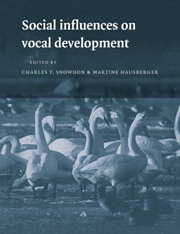Book contents
- Frontmatter
- Contents
- List of contributor
- 1 Introduction
- 2 Social interaction and sensitive phases for song learning: A critical review
- 3 Social interaction and vocal development in birds
- 4 Building a social agenda for the study of bird song
- 5 Field observations, experimental design, and the time and place of learning bird songs
- 6 Vocal learning in wild and domesticated zebra finches: Signature cues for kin recognition or epiphenomena?
- 7 What birds with complex social relationships can tell us about vocal learning: Vocal sharing in avian groups
- 8 Social influences on song acquisition and sharing in the European starling (Sturnus vulgaris)
- 9 Social influences on the acquisition of human-based codes in parrots and nonhuman primates
- 10 Vocal learning in captive bottlenose dolphins: A comparison with humans and nonhuman animals
- 11 Vocal learning in cetaceans
- 12 Social influences on vocal development in New World primates
- 13 Some general features of vocal development in nonhuman primates
- 14 Social influences on vocal learning in human and nonhuman primates
- 15 The resilience of language in humans
- 16 Reciprocal interactions and the development of communication and language between parents and children
- 17 Crafting activities: Building social organization through language in girls' and boys' groups
- Index
9 - Social influences on the acquisition of human-based codes in parrots and nonhuman primates
Published online by Cambridge University Press: 04 August 2010
- Frontmatter
- Contents
- List of contributor
- 1 Introduction
- 2 Social interaction and sensitive phases for song learning: A critical review
- 3 Social interaction and vocal development in birds
- 4 Building a social agenda for the study of bird song
- 5 Field observations, experimental design, and the time and place of learning bird songs
- 6 Vocal learning in wild and domesticated zebra finches: Signature cues for kin recognition or epiphenomena?
- 7 What birds with complex social relationships can tell us about vocal learning: Vocal sharing in avian groups
- 8 Social influences on song acquisition and sharing in the European starling (Sturnus vulgaris)
- 9 Social influences on the acquisition of human-based codes in parrots and nonhuman primates
- 10 Vocal learning in captive bottlenose dolphins: A comparison with humans and nonhuman animals
- 11 Vocal learning in cetaceans
- 12 Social influences on vocal development in New World primates
- 13 Some general features of vocal development in nonhuman primates
- 14 Social influences on vocal learning in human and nonhuman primates
- 15 The resilience of language in humans
- 16 Reciprocal interactions and the development of communication and language between parents and children
- 17 Crafting activities: Building social organization through language in girls' and boys' groups
- Index
Summary
INTRODUCTION
Most studies of the effects of social interaction on the ontogeny of vocal communication in birds and primates concentrate on the normal course of development of species-specific codes: how birds learn conspecific song, how nonhuman primates develop their natural repertoire of calls, and how human infants develop language. The effects of social interaction, however, are probably even more important during exceptional learning (Pepperberg 1985): learning that is unlikely to occur in the normal course of events. Such learning, defined and described below, has been documented for a number of species, including humans. I have been particularly interested in examining how social interaction can influence a specific type of exceptional learning – the development of interspecies communication between humans and birds. My research on the effects of social interaction on the acquisition of a vocal, English-based code by grey parrots (Psittacus erithacus) clearly demonstrates how social and environmental input1 can engender learning that would not otherwise occur (e.g., Pepperberg 1990a). Interestingly, an analysis of research on ape language also demonstrates how social interaction may be a particularly effective means of teaching nonvocal human-based communication codes to nonhuman primates.
Although characterizing the effects of social and environmental influences on exceptional learning is not a simple task, my work has shown that a conceptual framework, social modelling theory, can be used (a) to characterize how social input influences learning and (b) to delineate the critical features of input necessary for exceptional learning.
- Type
- Chapter
- Information
- Social Influences on Vocal Development , pp. 157 - 177Publisher: Cambridge University PressPrint publication year: 1997
- 10
- Cited by



